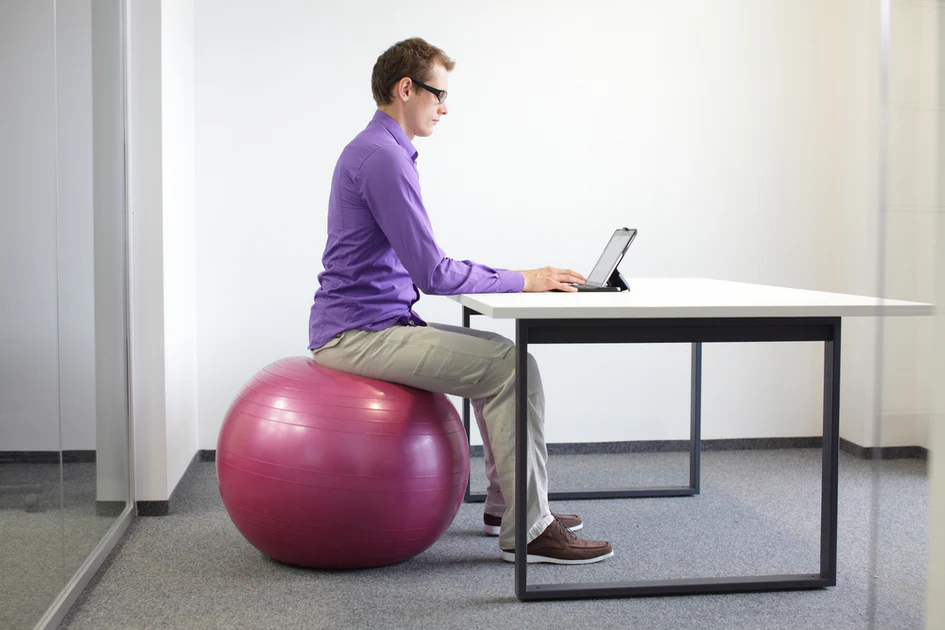In today’s fast-paced digital world, long hours at a desk have become the norm for most professionals. Whether you’re working from home or sitting in an office cubicle, spending extended periods in front of a computer can take a serious toll on your body. From stiff necks and sore backs to fatigue and poor posture, the effects of a sedentary lifestyle are far-reaching. However, the good news is that you don’t have to hit the gym to stay active. By sneaking a few simple exercises into your daily routine, you can counteract the effects of sitting, improve flexibility, and boost productivity — all without leaving your workspace.
Here are seven easy and effective exercises that you can incorporate into your hectic workday to keep your body moving and your energy levels high.
1. Seated Torso Twist – Relieve Tension and Improve Posture
Sitting for hours causes your spine and back muscles to become tight, leading to stiffness and pain. The seated torso twist helps loosen your back, shoulders, and oblique muscles while improving spinal flexibility.
How to do it:
- Sit upright on your chair with your feet flat on the floor.
- Place your right hand on the backrest of your chair and your left hand on your thigh.
- Gently twist your torso to the right while keeping your hips square and shoulders relaxed.
- Hold for 15–20 seconds, breathing deeply.
- Repeat on the other side.
Benefits: This exercise enhances posture, reduces lower back tension, and promotes better spinal alignment — ideal for those glued to their desks.
2. Shoulder Rolls – Ease Neck and Shoulder Stiffness
Constantly hunching over your keyboard can create tension in your neck and shoulders. Shoulder rolls are a simple yet powerful way to relieve tightness and promote blood flow in these areas.
How to do it:
- Sit or stand tall with your arms relaxed at your sides.
- Slowly roll your shoulders forward in circular motions for 10 rounds.
- Then reverse the motion, rolling them backward for another 10 rounds.
Benefits: Shoulder rolls help loosen stiff muscles, reduce upper back pain, and can even improve your posture over time.
3. Desk Push-Ups – Strengthen Your Arms and Core
Desk push-ups are an effective way to tone your upper body without needing to get down on the floor. This move engages your chest, shoulders, arms, and core, helping you feel more energized.
How to do it:
- Stand about two feet away from your desk.
- Place your hands on the edge of the desk, shoulder-width apart.
- Keep your body straight from head to heels.
- Lower your chest toward the desk, bending your elbows at about 90 degrees.
- Push yourself back to the starting position.
- Repeat 10–15 times.
Benefits: This mini-workout strengthens your upper body, engages your core, and increases circulation — a great energy booster during long meetings.
4. Seated Leg Lifts – Tone Your Legs and Improve Circulation
Sitting for long hours restricts blood flow to your legs, which can lead to swelling, fatigue, and even varicose veins. Seated leg lifts help strengthen your lower body while encouraging better circulation.
How to do it:
- Sit up straight with both feet flat on the floor.
- Lift one leg until it’s parallel to the ground.
- Hold for 10 seconds, then lower it slowly.
- Repeat 10 times for each leg.
- For extra intensity, loop a resistance band around your ankles.
Benefits: This exercise tones your thighs, enhances blood flow, and helps prevent stiffness in your lower limbs.
5. Neck Stretches – Relieve Stress and Tension
Working on a computer for hours often leads to a “tech neck,” where the neck and upper spine are strained. Neck stretches are essential to release this built-up tension.
How to do it:
- Sit or stand with your back straight.
- Slowly tilt your head to the right, bringing your ear toward your shoulder.
- Hold for 10 seconds, feeling the stretch on the opposite side.
- Repeat on the left side.
- You can also gently rotate your head clockwise and counterclockwise for added mobility.
Benefits: Reduces neck pain, prevents stiffness, and improves overall posture — especially beneficial if you spend most of your day looking at screens.
6. Seated Marching – Get Your Blood Flowing
If you’re feeling sluggish during a long workday, seated marching is an excellent way to wake up your body and re-energize your mind. It’s essentially a mini cardio move that you can do without leaving your chair.
How to do it:
- Sit upright with your back straight.
- Lift your right knee toward your chest, then lower it.
- Alternate legs as if you’re marching in place.
- Continue for 1–2 minutes.
- For an added challenge, pump your arms as you march.
Benefits: Improves blood circulation, prevents numbness, and adds a quick burst of energy during afternoon slumps.
7. Standing Calf Raises – Strengthen and Stretch
Standing calf raises are an excellent way to tone your legs and improve lower-body circulation, especially if you spend most of your time sitting.
How to do it:
- Stand behind your chair and hold the backrest for support.
- Slowly raise your heels off the floor, balancing on your toes.
- Hold for 2–3 seconds, then lower your heels back down.
- Repeat 15–20 times.
Benefits: This exercise strengthens your calves, boosts blood flow, and helps prevent stiffness and swelling in your feet and ankles.
Bonus Tip: Move Whenever You Can
While these exercises help combat the effects of prolonged sitting, the best way to stay healthy at work is to move frequently. Make it a habit to stand, stretch, or take short walks every hour. You can also:
- Use a standing desk for part of the day.
- Take phone calls while standing or pacing.
- Use the stairs instead of the elevator.
- Set reminders to stretch every 45–60 minutes.
Conclusion
Incorporating movement into your busy workday doesn’t require special equipment or much time — just consistency and awareness. The seven exercises above are easy, discreet, and effective ways to keep your body active, even when your job demands hours at a desk. Regular stretching and movement can improve your posture, boost energy levels, prevent chronic pain, and even sharpen your focus.
So the next time you find yourself glued to your chair, take a few minutes to stretch, twist, or march — your body (and mind) will thank you for it. After all, even the smallest movements can make a big difference when it comes to your long-term health.
Do Follow Us On Instagram







